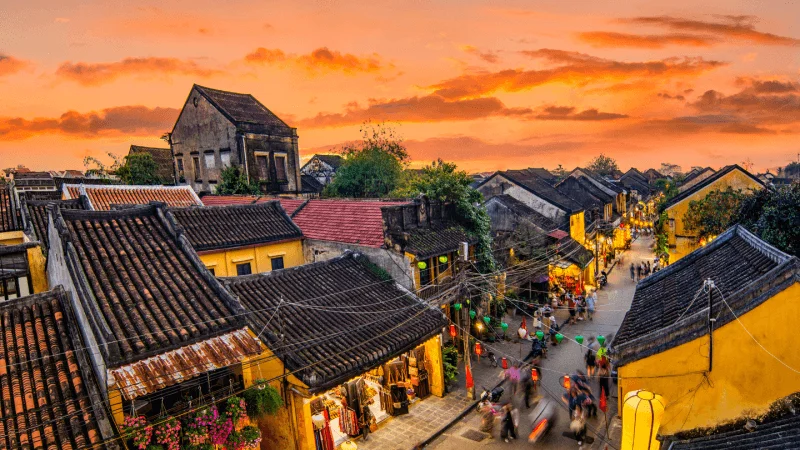Are you pondering when the best time to visit Vietnam is?
To help you choose the perfect time to travel based on different regions of the country, we’ve provided an overview of the best seasons for visiting Vietnam.
Whether you’re looking for the cool, crisp air of fall up north or resting on a beach during hot, clear days in the south, we’ll help you know when to plan your journey for the type of experience you’re hoping for.

When is the best time to visit Vietnam?
Thanks to its shape and a range of climates, there is no one singular best time to visit all of Vietnam, with each region having different optimal visiting times.
The north has four distinct seasons, central Vietnam has a split of two extremes, and the south gets a hot and rain split. Regular weather information and potential hazards should be a key part of your trip planning, with contacting the Vietnam National Hydrometeorological Forecast Center or following relevant local government social media channels offering the most up-to-date information.
Vietnam National Hydrometeorological Forecast Center: https://nchmf.gov.vn/KttvsiteE/en-US/2/index.html
Knowing the overall climate patterns makes sure you can plan around the best overall weather conditions for your visit to the regions you’re focusing on, maximizing your experience.
Best Time to Visit Northern Vietnam
Autumn: September to November
The best time to visit Northern Vietnam, at least in terms of weather and climate. Autumn in Northern Vietnam brings with it cool, dry weather, perfect for exploring Hanoi’s bustling streets or trekking the rice terraces of Sapa. Temperatures hover around 18-25°C (64-77°F), offer cool conditions for outdoor adventure, without extreme heat or monsoon rains.
Recommended sites to visit in autumn include:
Hanoi’s Old Quarter: soak up history and shop at the street markets.

Sapa Rice Terraces: Hike the terraced fields and visit hill shuttle villages.
Other Seasons in Northern Vietnam
Summer (June to August)
It gets hot and sticky, with temperatures over 30°C (86°F) though the landscape is at its lushest. Be prepared for afternoon showers.
Sites to visit in summer include:
Ban Gioc Waterfall: one of the largest natural waterfalls in all of Southeast Asia.
Hanoi Street Food Tours: experience the local cuisine in the capital.
Spring (March to May)
Temperatures are mild with occasional, light showers – perfect for exploring the natural wonders of Halong Bay or trekking in Ha Giang.

Halong Bay: cruise among the towering limestone karsts.
Ha Giang: discover the staggeringly beautiful loop, and the traditional cultures running along it.
Winter (December to February)
the North can be cold, especially in mountainous areas like Sapa where temperatures can drop below zero. It’s also the season of the fog and mist rolling over the landscape – and of less tourists.
Hanoi Coffee Culture: warm up with the city’s coffee scene.
Trang An Scenic Landscape Complex: enjoy a tranquil riverboat ride through the UNESCO World Heritage site.
Best Time to Travel to Central Vietnam
Harvest season: January to April
Central Vietnam is at its cashmere sweater best during the Harvest season. There’s typically little rainfall and temperatures are moderate, making for an excellent opportunity to visit the historic Hue or bustling Da Nang, with temperatures ranging from 20-30°C (68-86°F).
Recommended sites to visit during the Harvest season include:
Hue Imperial City: explore the history of the former capital of Vietnam.

Da Nang Beaches: discover the stunning beaches and beachfront cafes.
Other Seasons in Central Vietnam
Hot Season (May to August)
Temperatures can rise into the 40s°C (100s°F) along the coast, with humidity making it feel worse. It can be a tough season, but the coastal regions are at their most vibrant, and there’s life along the beaches and markets.
Rainy Season (September to January)
Rainclouds gathering, particularly in October/November, can lead to minor flooding. It’s less convenient for travelers, but the landscape can be dramatic – if you’re prepared for it.
Best Time to Travel to Southern Vietnam
Hot Season: February to May
The dry months when you’re most likely to enjoy the sun and sand of places like Nha Trang and Phu Quoc. Plan for temperatures of 28-35°C (82-95°F) for optimum sunbathing and beach-bound fun.
Recommended sites to visit during the Hot Season include:
Nha Trang Beach: dive, snorkel, bask in the sun.

Phu Quoc Island: glut on the fresh seafood.
Other Seasons in Southern Vietnam
Rainy Season (June to November)
Southern Vietnam’s rainfall is a bit of a misnomer – it’s generally a sprinkle compared to the torrents in the North, so it’s still excellent travel time. Enjoy the city life in Ho Chi Minh City while the weather keeps damp tourists away.
Cu Chi Tunnels: Discover the wartime plethora of activities held underground.
Ho Chi Minh City Markets: wander and snack through the traditional markets.
Harvest Season (November to February)
After the monsoons, the region will be verdant and overgrown: a good time to visit, though when the majority of other travelers will be.
Mekong Delta: explore the floating markets

Can Tho: boomtown hosts an annual festival to celebrate the history of the Mekong.
Summary
Choosing when to visit Vietnam is almost as important as where to go in Vietnam. Our travel guide to the best times to visit Vietnam by region should help you plan your journey, aligning the best concentration of adventure with the least chances of rain on your trip. Go Explore Vietnam!
